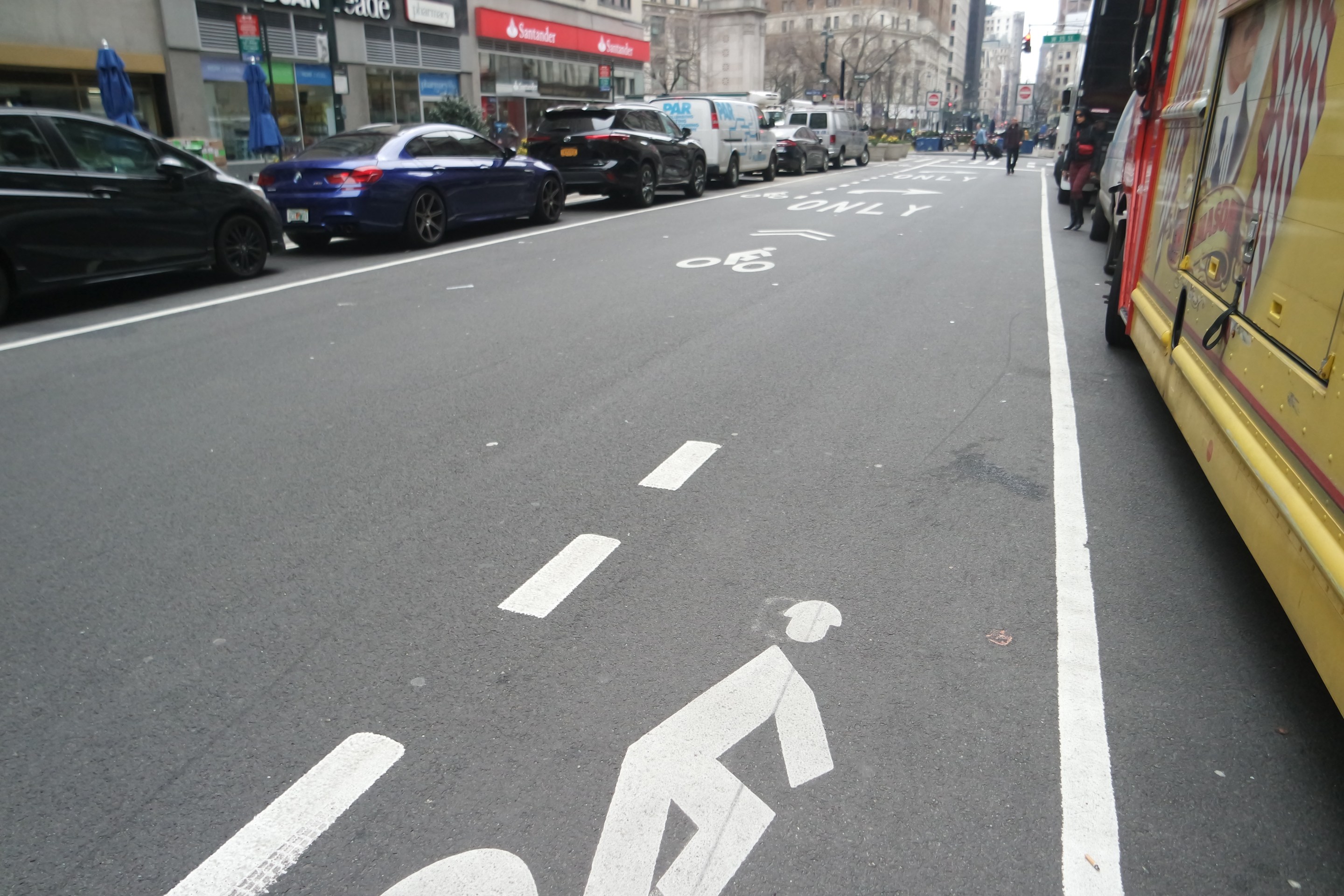What’s the matter with Broadway? From a cyclist’s vantage, pretty much everything.
As the city experiments with temporary schemes to pedestrianize parts of the old Native American trail, it’s clear that New York’s grandest boulevard needs a strategic plan for livability and road safety. Absent that, however, the city quickly needs to fix some dangerous situations for cyclists — the most neglected of Broadway’s users from the point of view of transportation planning.
The Department of Transportation has made many street-level improvements over the years — notably, the pedestrian plazas running from Times Square to Herald Square — but Broadway’s bicycle network amounts to a patchwork of bike lanes (protected, variously, by open space, parked cars, sidewalk extensions, medians, or plastic bollards) broken up by gaps of either unprotected, painted lanes or useless sharrows.
The piecemeal nature of the fixes produces an inconsistent and sometimes dangerous cycling experience. Even on protected stretches, the protection doesn’t continue into the intersections — the site of many car crashes — where sharrows leave cyclists vulnerable to drivers.
Protected bike lanes should have protected intersections. The DOT could make those simply by extending the bike lanes’ green paint, indicating to motorists that this space still belongs to bikes — or it could try the "Dutch approach," which maintains physical separation through intersections by the use of concrete islands. Separate signals and signal timing would allow cyclists special priority.
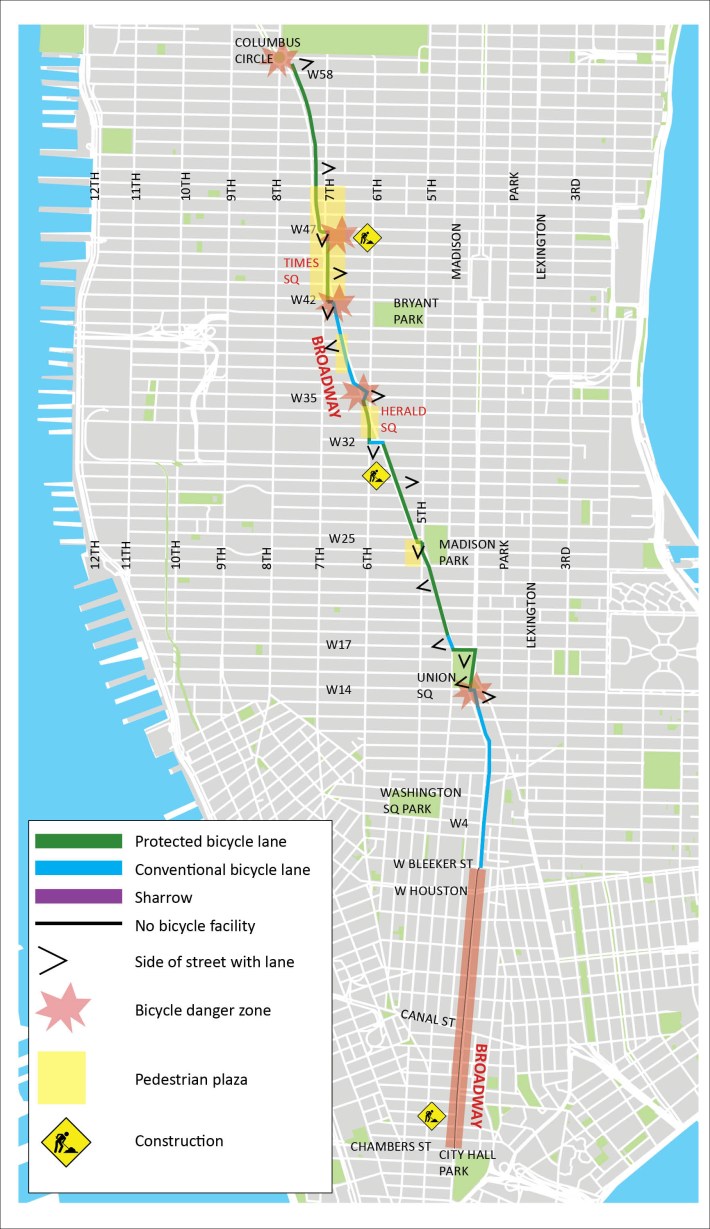
Streetsblog counted five cycling “danger zones” from Columbus Circle to Union Square (see map, right) — areas where the close and confusing mixing of cyclists and car traffic encourages crashes. Broadway is a crash magnet, with 362 crashes killing two pedestrians and injuring 398 people during the last five years.
The network also forces cyclists to cross to the other side of Broadway eight times (!) in order to stay in lanes and clearly was built not with their safety in mind but rather to minimize inconvenience to drivers.
Then there are matters of convenience rather than safety: The fact that Broadway only has a bike lane on one side of the street means that cyclists can’t easily stop to pop into a shop on the opposite side of the street. By circumscribing such mobility, one-way bike lanes make about as much sense as one-way sidewalks.
And good luck finding bike parking on Broadway. The small number of bike corrals always seem to be more than full, often with bikes stacked on top of each other. The demand for bike parking is definitely not being met.
Here’s some of what you’ll encounter as a cyclist on Broadway from Columbus Circle to City Hall:
Columbus Circle
Columbus Circle is hard to navigate — to put it mildly. The bike lane sits inside the four-lane traffic circle, with no direct connection to Broadway as the road veers south. Instead, cyclists must find the bicycle turn lane at West 59th Street, where they must wait for the pedestrian signal to cross, connecting them with a bike lane that eventually turns south onto Broadway. The rerouting adds a minimum of two minutes of travel time, so some cyclists opt to ride on the outside of the circle in traffic or to dodge across lanes to turn south directly onto Broadway.
This fix is a no-brainer: Bicycle-inclusive roundabouts, such as those in the Netherlands. Instead of requiring the most vulnerable road users to cross traffic to access their lane, the Dutch design gives priority to cyclists by keeping the bicycle lane on the outside and giving them direct access to each crossroad. Shockingly, motorists must also YIELD to cyclists when entering/exiting the roundabout. This gives cyclists the confidence they need to navigate a high-risk space.
See the well-functioning Dutch roundabout below posted by the Dutch Cycling Embassy:
Roundabouts are far safer than signalized intersections. There is not much debate about that fact in the Netherlands.
— Dutch Cycling Embassy (@Cycling_Embassy) March 5, 2020
In built-up areas, cycling must have priority over motor vehicles, making it more attractive and providing it an advantage over the car.https://t.co/HdFRQEuaEK pic.twitter.com/O4ZvRZxWF3
Times Square
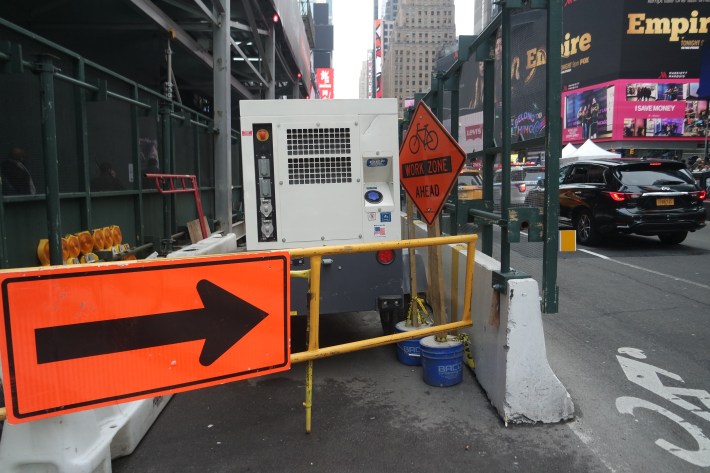
As cyclists approach 47th Street from the north, they are directed east toward Seventh Avenue on a protected bicycle path that circumnavigates the Times Square pedestrian plaza. Turning right onto Seventh Avenue, cyclists must cross to the left side of the street and onto a bicycle sharrow. Construction barriers leave no road shoulder and create a fear of getting pinned between the high volume of oncoming traffic and the barrier.
A better way would be to put a protected bike lane down the right side of Seventh Avenue, running along the east side of the plaza — or through the plaza itself. Giving cyclists space close to pedestrian space creates a safer and more comfortable experience and allows for the same interaction potential enjoyed by pedestrians.
36th Street to 35th Street at Herald Square
On Broadway traveling south between 36th and 35th streets there is an unprotected bicycle lane on the right side of the street. Just before 35th street, the lane jumps to the left side of the road — requiring cyclists to cut across traffic (see photo at the top of this post). Keeping the lane on the right side and placing a bike box before the crosswalk at 35th would be a simple fix that would do wonders for safety.
Union Square and 14th Street
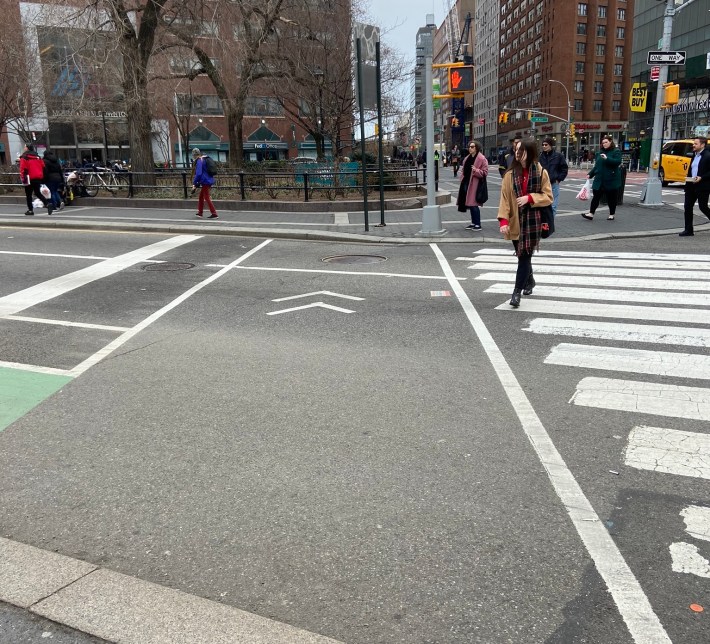
The protected bicycle lane on the right side of the street ends at the southeast corner of Union Square and 14th street. Here, traveling south, you’ll cross 14th and begin riding in traffic only to look left across Broadway and see an unprotected bike lane running south along the east side of the street. On closer look, a sharrow points cyclists to cross the street in front of the 14th street intersection — parallel to the crosswalk — in order to connect with the unprotected bike lane. This forces cyclists to pay attention to both car and pedestrian signals.
A bike box — and appropriate signage — would enable cyclists to get a head start in front of cars and would communicate that the bike lane is moving to the other side of Broadway.
Broadway south of Bleecker Street
At Bleecker Street the bicycle lane completely disappears — seemingly sacrificed for the bus-only lane that begins here. From there to City Hall, Broadway is a fast-moving car sewer without accommodations for cyclists.
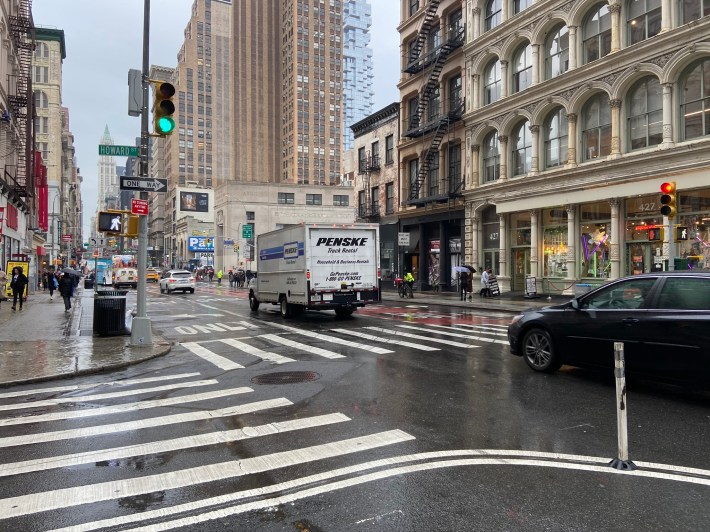
From a livability and safety perspective, most of Broadway underwhelms. Even with significant improvements in recent years, Broadway’s issues are far from solved. Instead of piecemeal improvements and a patchy bicycle network, the city needs a plan that puts people first and properly showcases Broadway’s larger role in the identity of New York City.
Lauren Rushing (@CycleRush) is a mobility consultant with knowledge and experience in bicycle urbanism in the Netherlands and the United States.
